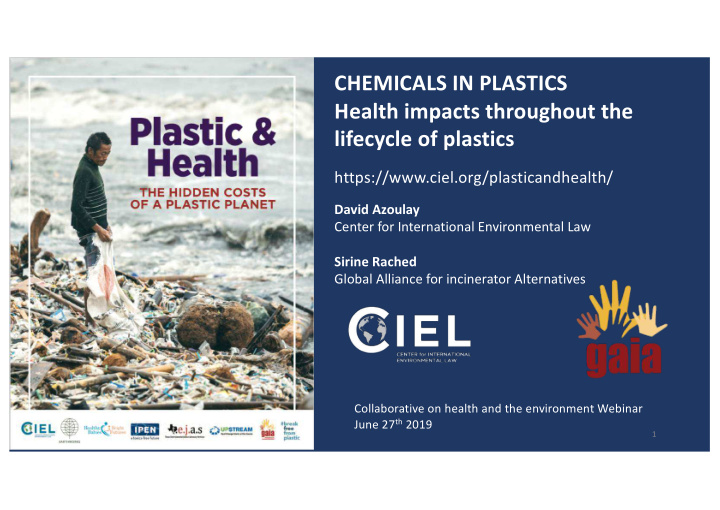



CHEMICALS IN PLASTICS Health impacts throughout the lifecycle of plastics https://www.ciel.org/plasticandhealth/ David Azoulay Center for International Environmental Law Sirine Rached Global Alliance for incinerator Alternatives Collaborative on health and the environment Webinar June 27 th 2019 1
2
Po Polymers, additives and “other” substances Thousands of additives for variety of functions (Phthalates, Brominated flame retardant, Lead compound, PoPs, antioxidants, stabilizers, color….). Up to 80% of the final product by mass (Some PVCs), but are around 20% on average Human exposure through variety of pathways Fragmentation makes plastic bio available Environmental plastics can leach toxic additives and concentrate toxins already in the environment Lack of transparency makes risk assessment relating to plastics extremely limited 3
Th The l life c cycle a approach Ø Extraction Ø Refining and manufacturing Ø Consumer use Ø Waste management Ø Plastics in the environment 4
5
6
7
8
By 2025, production capacity projected to grow by 1/3 rd for both ethylene and propylene. 9
• This new capacity would lock in a massive expansion of cheap plastic production for decades. • If the boom is not addressed, it could largely undermine efforts to reduce plastics use and pollution. 10
So Solu lutio ions s and ways s forward Co Complex life cycle and variety of actors will require variety of solutions and options Ø Put human health and human rights at the core of any future approaches Ø Make the invisible visible – Transparency is key Ø Avoid false solutions Ø Think globally, act everywhere. 11
Tr Triple COP, U , UNEA and and be beyond nd Stockholm : Recycling exemptions and Low POPs waste Basel : Norwegian amendment UNEA : Process towards a new multilateral instrument on Plastic pollution Learn more at https://www.ciel.org/reports/unea-progress-on-plastics/ 12
The global plastic waste trade: Changes in international rules
Th The Ba Base sel Co Convention amendment Ø Basel Convention 1.01: Green, Yellow and red list Before the amendment All plastic waste = Green list (except hazardous as defined in annex 1 & 3) Learn more @ https://wastetradestories.org/ 14
After the Amendment All plastic waste = yellow list except: Plastic waste almost exclusively consisting of ONE non halogenated polymer (PE, PP, • PS, PP, ABS..) Mixtures of plastic wastes, consisting of polyethylene (PE), polypropylene (PP) or • polyethylene terephthalate (PET), provided they are destined for separate recycling of each material and in an environmentally sound manner, and almost free from contamination and other types of wastes. Plastic waste almost exclusively consisting of ONE cured resin or condensation • products Plastic waste almost exclusively consisting of ONE of the listed fluorinated waste • Provided it is destined for recycling in an environmentally sound manner and almost free from contamination and other types of wastes 15
More details at: http://wiki.ban.org/images/1/10/Briefing_Paper_2_May_2017.pdf https://www.ciel.org/empowering-countries-stop-plastic-flood-basel-amendment/ https://www.ciel.org/wp-content/uploads/2018/06/Progress-on-Plastics-Update-Issue-11- BRS-COP-May-2019.pdf
Challenges ahead: - Situation until entry into force, 1 Jan 2021 - Enforcement - Revision of amendment (cured resins and fluorinated Polymers) - plastic waste (co)incineration
THANK YOU FOR YOUR ATTENTION AND QUESTIONS https://www.ciel.org/plasticandhealth/ Sirine Rached Contact: David Azoulay sirine@no-burn.org dazoulay@ciel.org 18 Kuala Lumpur SAICM regional meeting, March 23rd / 27th 2014
Recommend
More recommend